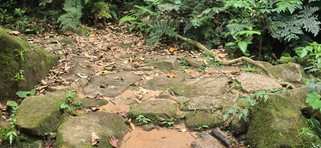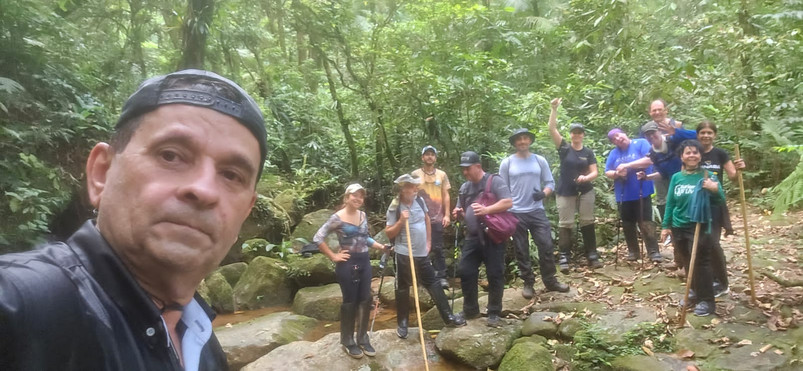
At the end of November, a Dakila Research team conducted an expedition to the Santa Catarina region. The mission, marked by intense activities, aimed to investigate the intriguing Peabiru Trails and ancient historical routes that connected different peoples of South America. With the collaboration of mountaineer and researcher from Brazil Primitivo André Rockemback, historian Henrique Kuhne, writer Isaque de Borba, and university professor Fátima Vieira, the team explored sites of great archaeological relevance by land and air, uncovering the historical significance of these ancient routes.
A large part of the expedition occurred in Garuva, a city in Santa Catarina that captivated the Dakila team with its unique natural formations. These formations, along with historical accounts that indicate the possible passage of the Peabiru through the region, added a sense of wonder to the expedition.
The expedition began with a strategic flyover over the Campos do Quiriri and Monte Crista. From above, the team sought to identify possible features that could indicate the presence of the Peabiru Trails in the region. This stage was essential for mapping areas of interest and selecting priority points for analysis on the ground. During the flight, a rectilinear formation of rocks, a potential marker of the Peabiru Trails, caught attention. This suggested more detailed studies with advanced technologies and potentially revealing new insights into the ancient routes.

This formation is a geodesic alignment of rocks on top of the hill. Because of its symmetrical patterns, this formation may indicate human intervention in the distant past, suggesting the existence of ancient pre-flood civilizations in the region.
Urandir Fernandes de Oliveira, CEO of Dakila Pesquisas, established connections with the enigmatic Göbekli Tepe in Turkey by studying the discovery and comparing it to other archaeological sites worldwide. This relationship strengthens the theory that ancient civilizations could have exchanged architectural and cultural knowledge, transcending geographic and temporal boundaries.
LiDAR technology was used at the site to reveal structures hidden beneath dense vegetation. Given the similar symmetry of the formations found with the stones present at Göbekli Tepe, the researchers plan to return to the site to apply GPR (Ground Penetrating Radar). This tool, which detects elements below the surface, promises to provide more detailed data, allowing a more profound understanding of what is found in the region.
The following day, the group was divided; the key team comprised Fernanda Lima, Fernando Andreazza, Henrique Kuhne, Douglas Schon, the helicopter commander, and the co-pilot Ricardo. They were responsible for conducting a LiDAR analysis on the Campos do Quiriri mountain. At this stage, Schon, the local mountaineer who specialized in geography, was essential in mapping potential trail sections, thanks to his extensive knowledge of the region's topography. Due to the cloudy temple, the group was almost forced to camp at the site, considering the risks of flying at that time. Upon hearing the news, the second team began working on the logistics of sending food, sweaters, and ropes. Despite the unforeseen events around 6 pm, the helicopter commander completed the journey and landed safely.
After great adventures, the third day of the expedition was marked by recordings from NSC, a local channel affiliated with Rede Globo. The report on the expedition aired on Tuesday, November 26, on the Bom Dia SC program, available at the link: https://youtu.be/JpEEGnavYQ4?si=KKr-_XWDgnCSBz3o. Interviews were conducted with Dakila CEO Fernanda Lima, Research Director Larissa Kautzmann, Director Fernanda Andreazza, Chief of Technology, writer Isaque de Borba, and mountaineer and researcher at Brasil Primitivo André Rochemback.

In addition to the recordings, part of the team flew over to explore Castelo dos Bugres and other mountains in the region. During the expedition, they visited Fátima Vieira's company, known for its work with geodesic domes. The group was then welcomed into the home of a sculptor, where a sculpture of Saint Thomas was being finished, prepared at Fátima's special request as a gift for Dakila.

On the last day of the expedition in Santa Catarina, the research team faced a challenging 11 km hike on Monte Crista, following the historic Caminhos de Peabiru trail. During the 7-hour journey, marked by adverse weather conditions, the researchers recorded necessary evidence reinforcing the region's importance, such as the stone paths. Despite the difficulties, the trail, linked to ancient indigenous routes, highlighted the great potential for future discoveries in the area.
With promising discoveries and new stages of research planned, Dakila Pesquisas reaffirms its commitment to science and history, shedding light on the mysteries surrounding this ancient trail.
This expedition to Santa Catarina is essential in preserving and understanding the Peabiru Trails. “This route is more than history; it is a legacy of humanity. We are uncovering a past that connects cultures and reveals the role of our ancestors in building the world as we know it today,” stated historian Henrique Kuhne.
The preliminary data analysis reinforced the hypothesis that the region contains significant traces of ancient routes. These initial discoveries excited the team, who saw new possibilities for study.
The team plans to return to the region for analyses using GPR (Ground Penetrating Radar), a technology that identifies underground structures. This step will be essential to determine whether the formations detected are natural or if the work of ancient civilizations could have used the Peabiru Trail as a route for integration and trade.


















Comments